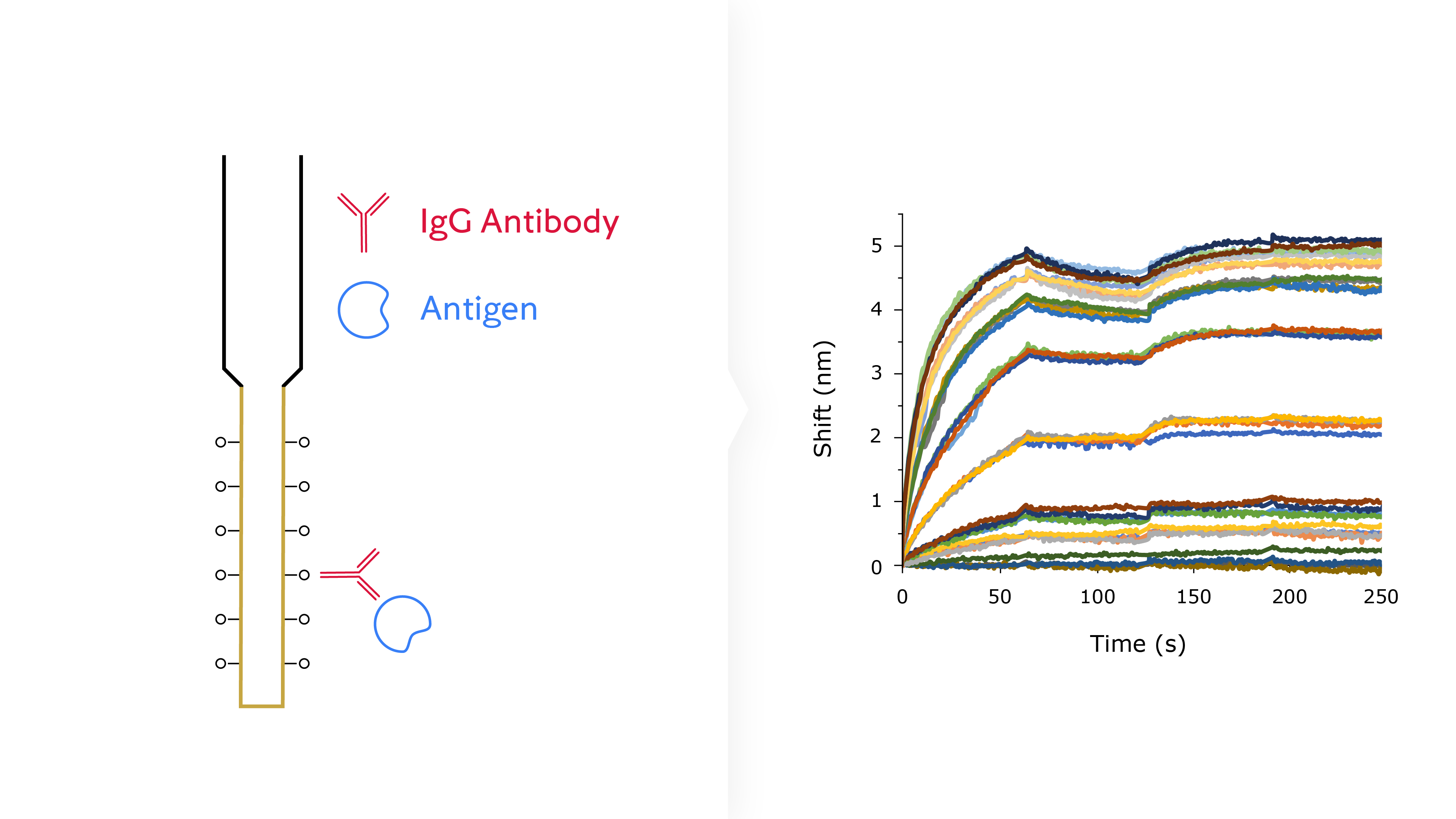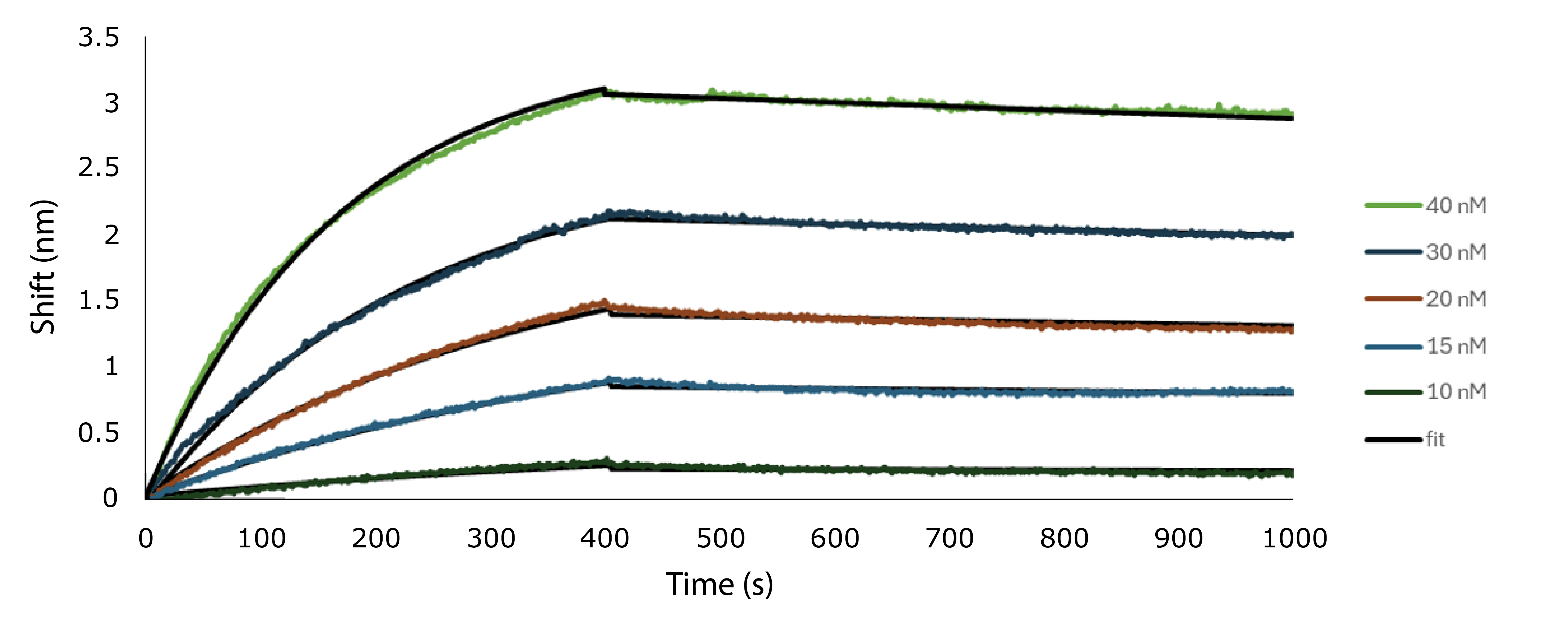
Analyze complex protein interactions directly in samples with our fast, simple-to-use immunoassay, perfect for at-the-bench automation to streamline your next biologics discovery.
- Perform bioassays directly in the sample, without protein purification. Measure in cell culture, lysates, plasma, or blood.
- Rank affinities of proteins, antibodies, antigens, single domain antibodies, biomarkers, receptors and ligands, either label-free or gold nanoparticle-enhanced to boost signal.
- Measure bioreceptor-target binding kinetics, affinity (kD) and on & off rates (kon, koff) at your bench, no instrument expert required.
Case study: Label-free potency assay
Screen antibody libraries quickly, easily, and label-free to identify those with optimal affinity for antigens calculated from the on and off rates.
Capturing the antibodies on the probe allows antibodies to be tested against all of the antigen’s possible binding sites.
Case study: Kinetic analysis of VHH and antibodies with WHITE FOx
Measure binding affinity kinetics in real time with WHITE FOx, even for low molecular weight antibodies like VHH. Flexibility in assay design addresses challenging experimental setups commonplace in bivalent antibody kinetic studies.
- Rapid, straightforward direct-in-sample assay with limited sample prep and no microfluidics.
- Precise data on high-affinity interactions, with simple to run hands-off protocols.
- Explore the kinetics with standard one-to-one kinetics, or more complex models if needed.
Case study: Affinity determination of single domain antibodies for detection of biomarkers
WHITE FOx provides the crucial affinity and kinetic binding information missed in other assays like ELISA. With our immunoassay, you can rapidly and robustly determine the best binder of a biomarker.
- Fast and easy to use with minimal processing.
- Label-free kinetic characterization.
- Mechanistic insights of kinetics with individual determination of kon, koff and kD.
- Intuitive method setup.
- Provides insights missed by traditional assays.
Relevant publications
Page 1 of 1
App Note: AN4 How to select your best performing single domain antibodies
A fast, dip-in assay can provide comprehensive kinetic analysis to determine the most appropriate binding proteins Single domain antibodies (sdAbs) have an improved capacity to penetrate tissues, making them powerful...
May 14, 2024
App Note: AN2 Can you get immediate kinetic characterization from phage display clones?
More efficient biotherapeutic discovery and screening using a fast, dip-in assay WHITE FOx can measure the kinetics of phage clones to provide insights into their affinity and avidity, providing a...
White paper: WP10 Kinetic analysis of VHH and antibodies with WHITE FOx
White paper 10 | Version 1 | Tobias Zbik, Sarah Parmentier, Kris Ver Donck ABSTRACT The landscape of antibody research continuously evolves, with novel antibody variants such as VHH, antibody-drug...
April 23, 2024
White paper: WP8 Affinity determination of single domain antibodies for detection of biomarkers
White paper 8 | Version 2 | Laura Marin, Sarah Parmentier, Kris Ver Donck, Filip Delport SUMMARY Single domain antibodies (sdAbs) and adhirons are an alternative to conventional antibodies for...
November 20, 2023
White paper: WP7 Versatile and fast IgG screening with the Protein A sensor probe
White paper 7 | Version 2 | Kris Ver Donck, Filip Delport, Laura Marin, Emma Buchet, Kim Stevens SUMMARY FOx BIOSYSTEMS’ fiber-optic surface plasmon resonance technology (FO-SPR) is a robust...
March 20, 2023
Detection of Breast Cancer-Specific Extracellular Vesicles with Fiber-Optic SPR Biosensor
Yildizhan et al. (2023) International Journal of Molecular Sciences DOI: 10.3390/ijms24043764 Extracellular vesicles (EVs) have attracted great attention as potential biomarkers for cancer diagnostics. Although several technologies have been developed…
February 15, 2023
New technology for the development of molecular markers
Georg Johnen, Thomas Brüning, IPA (Institut für Prävention und Arbeitsmedizin der Deutschen Gesetzlichen Unfallversicherung) The detection of specific proteins is the focus of many methods for the diagnosis of occupational…
December 7, 2022
White paper: WP6 Using FO-SPR to select for nanobodies in phage display
White paper 6 | Version 2 | Kris Ver Donck, Dagmara Minczakiewicz, Filip Delport, Kim Stevens Based on original publication: Knez et al. (2013) Analytical Chemistry 85, 10075 - 10082...
April 29, 2022
Innovative FO-SPR Label-free Strategy for Detecting Anti-RBD Antibodies in COVID-19 Patient Serum and Whole Blood
Qu et al. (2022) ACS Sensors DOI: 10.1021/acssensors.1c02215 The ongoing COVID-19 pandemic has emphasized the urgent need for rapid, accurate, and large-scale diagnostic tools. Next to this, the significance of…
January 27, 2022
WHITE FOxTM technical specifications
You can find the technical specifications of the White FOxTM here: DOWNLOAD
April 8, 2021
Affinity comparison of p3 and p8 peptide displaying bacteriophages using surface plasmon resonance
Knez et al. (2013) Anal. Chem. 85, 10075−10082 Ever increasing demands in sensitivity and specificity of biosensors have recently established a trend toward the use of multivalent bioreceptors. This…
September 30, 2013
Page 1 of 1
For Research Use Only. Not for use in diagnostic procedures.



